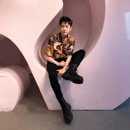Anime has gained a reputation of being pretty misogynistic, and it’s for good reason. Most shows in the shonen and seinen genres, which specifically target boys and men, reduce women to being love interests, fanservice, and damsels in distress.
But that doesn’t mean anime should be written off completely. There are plenty of shows that place women at the forefront and tell stories of girlhood, womanhood, and female empowerment. And one of my favorites, and also one of the pioneers of woman-led action anime, is Pretty Soldier Sailor Moon.
Sailor Moon is an absolute classic. As the godmother of magical girl anime, it reshaped the genre and birthed countless stories that adopted its tropes. Before Naoko Takeuchi, the author, created this franchise, magical girls were usually young girls with witch-like powers who lived fun but quite lives (think Sabrina the Teenage Witch — the original one — but in elementary school). Then came Sailor Moon, a show that featured teenage girls becoming magical warriors to fight evil and fulfill their destinies as heroes. After that came Cardcaptor Sakura, Wedding Peach, Tokyo Mew Mew, Pretty Cure, Puella Magi Madoka Magica, and the list goes on.
This show has completely shaped my life; some of my earliest memories are of me watching the teenage superhero Sailor Moon battle a new monster every day on my family’s VCR player. The beautiful designs inspired me to pick up visual art, and the embracement of femininity granted me solace as a young boy growing up in a conservative and very Catholic Korean family. It’s probably one of the most influential and recognized anime of all time too, and I’m sure you’ve seen some of the characters on your Twitter or Instagram feed.
On the surface, the premise seems simple. A teenage schoolgirl named Usagi Tsukino is granted the power to transform into the magical superhero Sailor Moon by a talking cat named Luna and fights evil every episode, all while finding new friends and comrades along the way. Usagi and her friends go to school, deal with crushes and relationships, and worry about their day-to-day lives like any other teenager.
The story is far more complex than that, though. The narrative takes place on a galactic level, inviting characters from other worlds and expanding the stakes of our heroes’ fights. What follows this expansion of plot and conflict is the maturation and development of the main characters. The characters themselves experience heartbreak, grief and loss, and philosophical dilemmas, and as more characters enter the narrative, the once-simple theme of friendship and camaraderie becomes muddled.
We also need to take a moment and appreciate the work of the author. The lore behind Pretty Soldier Sailor Moon becomes quite expansive, especially in the manga, as the author draws on various mythologies to create a beautifully designed universe for the story to take place in. Her illustrations and designs are also gorgeous, and the characters themselves are so full of life and individuality. There’s a reason the designs have become an aesthetic on Instagram and Twitter; they’re absolutely stunning.
And from a feminist perspective, Sailor Moon is quite admirable. Despite being from the ’90s, a time when superheroes and cartoon heroes were nearly all men, Sailor Moon features an almost entirely female cast of girls with dynamic stories and personalities. And if that wasn’t great enough, there are multiple LGBTQ+ characters.
But, how can we forget our main character, Usagi Tsukino herself? As far as superheroes go, she’s as relatable as they can get. She’s a whiny crybaby who spends most of her time playing video games and eating snacks (which is why she fails most of her tests), and her vices seem to take up more screentime than her virtues. As the story progresses, though, we begin to see her heart of gold and desire to always protect those who can’t protect themselves. This strong moral compass and her incredible magical power allow her to be an incredible hero that reminds the show’s audience of young girls to know that they can do anything they put their minds into. And, that they can kick ass, because that’s important too.
It’s also worth noting that Sailor Moon promotes female empowerment without stigmatizing femininity. The Sailor Soldiers, which are what our female heroes are called, have incredible superpowers and fight planet-destroying monsters while wearing cute outfits and high heels. Sailor Moon’s weaponry consists of pink wands decorated with moons and hearts. Sailor Venus’s deadliest attack is a giant heart that she summons with a kiss. Sailor Neptune’s main weapon is a magic hand mirror. They’re not powerful despite their femininity; they’re powerful because of it.
That’s not to say every character embodies traditional femininity, however. Sailor Uranus is a butch lesbian who’s a racecar driver and wears men’s clothing (when not transformed, of course). Sailor Jupiter is taller than most of her male peers and can beat up grown men without breaking a sweat. The cast explores the diverse range of gender identity and presentation.
If you’re interested in experiencing this incredible work, I definitely recommend both watching the anime and reading the manga. Despite technically being the same story, the two have very different storylines. As the manga is the direct work of the original author, this is Sailor Moon in its truest form, and I personally think this version has the most interesting plot (the fight scenes are also cooler and more dramatic, if that interests you).
The anime, on the other hand, is the iconic medium that impacted the world, and the character development in the anime is far better. Both are incredible, however, and anybody who’s interested in Sailor Moon should explore both. There are also video games, a live-action show, and a recently done remake anime, but those two are the quintessential forms of this magnificent work.
All in all, Pretty Soldier Sailor Moon pioneered female representation in action anime, and as the face of female-led anime, it’s the first you should turn to if you’re looking for feminism in the genre.
Want to keep up with HCBU? Make sure to like us on Facebook, follow us on Instagram, check out our Pinterest board, and read our latest Tweets!



